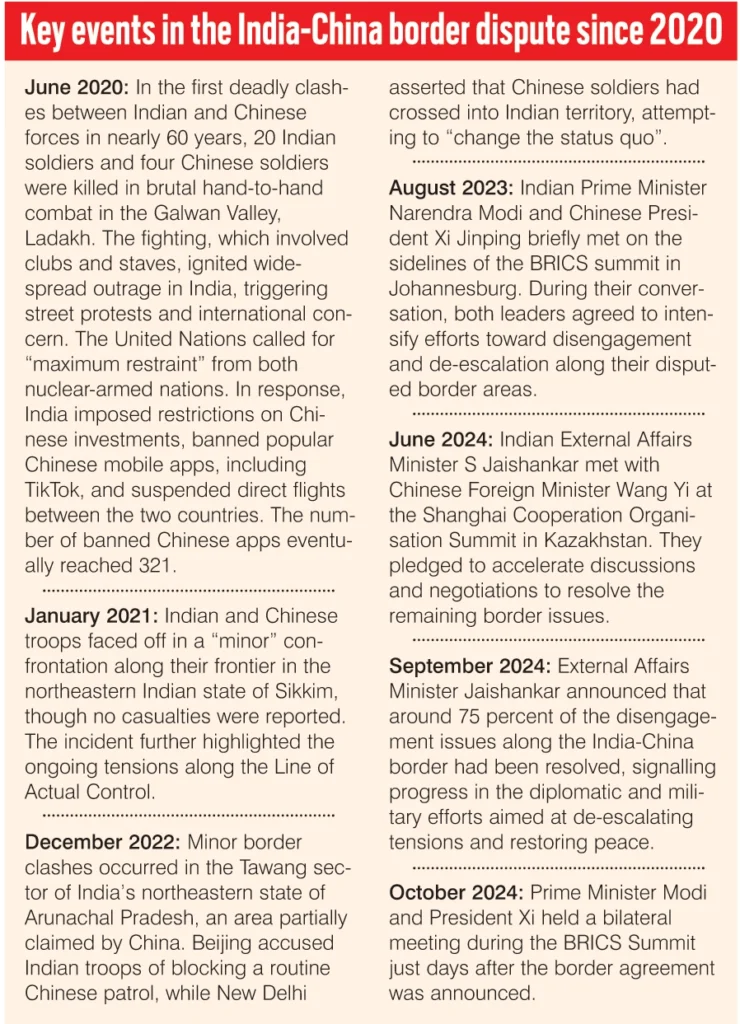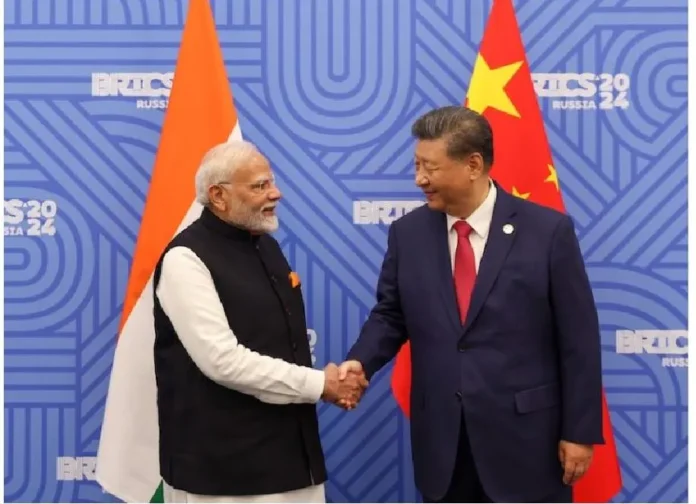By Annunthra Rangan
In a significant diplomatic and military development, India and China have reached an agreement to resume patrolling along the Line of Actual Control (LAC) in Eastern Ladakh, reverting to the pre-2020 patrolling norms. This agreement, a product of prolonged negotiations, could potentially ease tensions that have persisted since the 2020 standoff. However, questions remain about its long-term impact on the overall security and stability along the LAC, given the entrenched positions of both sides.
The standoff between the Indian Army and China’s People’s Liberation Army (PLA) began in April 2020, following a series of Chinese incursions into areas that India claims as its own along the LAC. The most notable flashpoints during this period were in Galwan Valley, the Pangong Tso Lake area, and the Depsang Plains. The confrontation reached a critical point in June 2020, when a deadly clash in the Galwan Valley resulted in the deaths of 20 Indian soldiers, while China reported an unspecified number of casualties. Since then, the situation has remained tense, with both sides deploying tens of thousands of troops to the region and ramping up infrastructure development.

The agreement to resume patrolling along the earlier perceived LAC is seen as a positive step in restoring a semblance of normalcy to the region. India’s External Affairs Minister S Jaishankar described the agreement as a “major diplomatic success”, acknowledging that it allows both sides to return to patrolling the LAC as it existed before the tensions erupted in May 2020.
Patrolling rights for Indian troops, particularly in critical areas such as the Depsang Plains and Demchok, had been severely restricted due to Chinese roadblocks and infrastructure development.
The resumption of patrolling is not merely symbolic; it signals a potential shift in the stalled process of disengagement and de-escalation along the LAC. However, experts caution against viewing this as a breakthrough. While the agreement provides for the return of Indian patrols to areas like Patrolling Points (PPs) 10 to 13 in the Depsang Plains, where Chinese troops had previously obstructed access, the long-term impact remains uncertain. The Depsang Plains, located in the northwest of Ladakh near the Daulat Beg Oldie (DBO) sector, have been a contentious area for years, with the PLA making incursions as far back as 2009. The flat terrain of the plains allows for easy movement of troops and vehicles, making it strategically important for both sides. Since 2011, China has built a 30-km road from Raki Nallah, which has significantly strengthened its position in the region. Indian patrols in this area have been hindered by the PLA’s presence at the “bottleneck,” a critical point that prevents access to PPs 10 to 13.
The agreement suggests that the PLA will no longer block Indian patrols from reaching these points, although this is met with scepticism due to the extensive Chinese infrastructure development in the area. Satellite imagery has revealed the construction of new PLA settlements and military positions in the Depsang Plains, raising concerns that China may be unwilling to dismantle these positions as part of the disengagement process. Similarly, in Demchok, the PLA has been obstructing Indian patrols at the Charding-Nilung Nalla junction since 2018, where they have pitched tents and established a presence. The Charding La Pass, a 19,120-foot-high peak patrolled by the Indian Army, remains a strategic area. While the agreement may allow for the resumption of patrols here, it is unclear whether the PLA will fully withdraw from its positions or if both sides will agree to a “no-patrol” zone as a compromise.
Despite the resumption of patrolling, the underlying issue of disengagement remains unresolved. Patrolling is inherently an aggressive act aimed at asserting control over territory, and without complete disengagement, it risks further escalating tensions. The presence of troops in close proximity to each other along the LAC, combined with the aggressive nature of patrols, makes the situation volatile. In regions like the Depsang Plains and Demchok, where both sides have heavily fortified their positions, a complete military rollback seems unlikely. Over the past four years, both India and China have significantly upgraded their military infrastructure in the region. India’s construction of the 260-km Shayok-DBO road has given its forces a strategic advantage in the Depsang area, allowing for the rapid deployment of troops and boosting their morale in this challenging terrain. Similarly, aviation infrastructure upgrades in the DBO and Nyoma sectors have enhanced India’s ability to operate in the region. China, on the other hand, has built roads, bunkers, and other military installations in areas it controls. This militarization, combined with the extensive fortifications on both sides, complicates efforts to achieve complete disengagement and de-escalation. The agreement on patrolling, while a step towards peace, does not address the core issue of military build-up.
The agreement on patrolling rights follows 21 rounds of Corps Commander-level talks and several diplomatic engagements between India and China. Foreign Secretary Vikram Misri, in his comments, emphasized the role of patient diplomacy in reaching this point. The negotiations began after a meeting between Indian External Affairs Minister Jaishankar and his Chinese counterpart Wang Yi in Moscow in 2020. Since then, both sides have engaged in multiple rounds of talks, aiming to resolve the stand-off in Eastern Ladakh.
During the Modi-Xi meeting in Kazan, both leaders facilitated delegation-level discussions that paved the way for Special Representative Dialogue aimed at negotiating the de-escalation of military build-up along the 3,488-km LAC. Additionally, the foreign ministers of both nations are set to establish a roadmap for normalising bilateral relations. Similar diplomatic breakthroughs have occurred in the past, such as the resolution of the Doklam standoff ahead of the BRICS Summit in 2017 and the de-escalation in Galwan Valley during the Shanghai Cooperation Organisation Summit in 2022.
Although disengagement from the Gogra-Hot Springs-Khugrang Nullah area was announced on September 9, 2022, India has maintained a firm stance on resuming patrolling rights in the Depsang Bulge and Demchok, underscoring that progress towards normalisation hinges on fulfilling these key military conditions. To avoid reopening contentious issues that might escalate tensions, the current patrolling agreement was limited to the Western Sector, where the Indian Army and PLA had blocked each other at Depsang and Demchok along the 1,597-km boundary in Eastern Ladakh.
This agreement allows India valuable diplomatic space, ensuring that any potential vulnerabilities involving China are minimised. Although patrolling has yet to resume in Depsang and Demchok, the agreement has contributed to a reduction in tensions along the Eastern Ladakh LAC and a gradual easing of the overall border situation.
With disengagement now complete and patrolling resumed, India and China must work out the details of de-escalation, as over 50,000 troops, along with tanks, missile units, and rocket regiments, remain positioned on both sides of the LAC. Additionally, fighter jets are stationed at rear bases, with China’s in Tibet and the Xinjiang region, while India has positioned its aircraft from Srinagar to Gwalior to Tezpur.
However, despite these diplomatic efforts, trust between India and China remains fragile. The LAC, which has never been formally demarcated, continues to be a source of friction. China’s incremental advances and strategic land grabs, coupled with India’s determination to defend its territorial claims, make it difficult to achieve a lasting resolution. The new patrolling agreement, while an important step, is unlikely to lead to a complete rollback of Chinese positions in areas like Depsang and Demchok.
The agreement to resume patrolling along the LAC is a welcome development, but it is not a comprehensive solution to the broader issue of disengagement and de-escalation. Without a full military rollback and a clear strategic understanding between the two sides, the situation in Eastern Ladakh is likely to remain tense. Both India and China have invested heavily in fortifying their positions along the LAC, and these defences cannot be dismantled without a significant shift in bilateral relations.
As winter approaches, patrolling activities are likely to be suspended due to harsh weather conditions, providing both sides with an opportunity to explore further diplomatic solutions. In the meantime, the resumption of patrolling represents a cautious step towards restoring peace and tranquillity along the border, but it is far from a breakthrough. The true test of this agreement will come in the months ahead, as both sides navigate the complex dynamics of military disengagement and seek to reset their bilateral ties.
The agreement reached just before the BRICS summit provided India with the diplomatic flexibility to facilitate a meeting between Prime Minister Narendra Modi and President Xi Jinping on the sidelines of the event. The existence of a border deal made it politically easier for New Delhi to agree to such an encounter. Economic relations, likely, played a significant role in shaping this agreement. China has been one of India’s top two trading partners, alongside the United States. In both 2023 and 2024, China was India’s largest trading partner, with bilateral trade reaching $118.4 billion. Additionally, China remains India’s primary source for goods and industrial products, from telecommunications equipment to essential raw materials for the Indian pharmaceutical industry.
For China, easing border tensions aligns with its broader ambitions to expand its global influence, particularly through multilateral forums such as BRICS. Chinese companies, which faced notable hurdles in India after 2020 due to tighter investment rules and the banning of popular Chinese apps, are eager to restore business ties. Pressure from India’s business community also played a role in driving efforts towards the border agreement.
—The writer is a Research Officer at Chennai Centre for China Studies. Her research interests constitute China-WANA (West Asia and North Africa) relations and human rights


